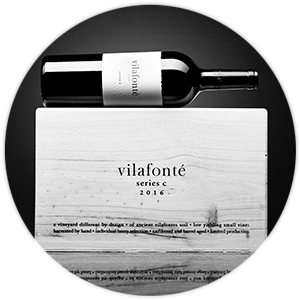Legendary soil scientist David Saayman is renowned for documenting ancient soils throughout the Western Cape. He mapped the vilafontes soils on our property in 1997.



Yes, we are serious about dirt – old dirt.
Soil is the foundation for the vine plant, and the character of the soil is what gives the vine, its grapes and the resulting wine a uniquely defined personality. The Cape winelands of South Africa have some of the oldest soils in the world, originating one billion years ago when the earth cracked-up at the foot of continent Africa. This is serious, so are we.
That is why Seriously Old Dirt is committed to making wine from vines growing on soils originating from the birth of the earth.

Legendary soil scientist David Saayman is renowned for documenting ancient soils throughout the Western Cape. He mapped the vilafontes soils on our property in 1997.


Head winemaker of Seriously Old Dirt Arlene Mains
Arlene Mains has been head winemaker for Seriously Old Dirt since April 2021. Arlene is highly qualified and obtained a Bachelor of Science degree in Viticulture and Oenology from The University of Stellenbosch. Arlene was awarded a Master of Science degree in Wine Biotechnology after completing a Master’s thesis titled “Evaluating the Impact of yeast co-inoculation on individual yeast metabolism and wine composition’.
Arlene is a serious winemaker with multiple vintages at Opus One winery in California, a vintage at Mouton Rothschild in Bordeaux and prior experience with Rupert & Rothschild, Bellingham, Kaapzicht Estate, et al under her belt. Her singular focus and sole responsibility is the ongoing quality development of Seriously Old Dirt. This single winemaker for a single wine is relatively unique in South Africa, and indeed in the world.
Arlene has a dog named Vino, listens to jazz and likes to go running on the weekends.





Winegrower Edward Pietersen
Owners: The Ratcliffe Family
Farm name: Vilafonté Vineyard, Portion 19, Farm Simonsvlei 791
Vineyard age: 1997 and later
Founded in 1997, the 42ha estate on the bench of the Simonsberg Mountains with its unique vilafontes soils, served as the fuse to our vision. Cabernet Sauvignon, Cabernet Franc, Merlot and Malbec confirmed its affinity to the ancient soils. Planted at high density, these vines adhere to the exquisite struggle; encouraging smaller vines, lower yields and highly concentrated fruit. Vilafonté wines are exclusively from grapes grown on our property.
Although there is much variation in the climate of the Western Cape, the biggest influence on wine growing in South Africa is the presence of the Atlantic and Indian Oceans. The cooling maritime influence has created what can be described as a Mediterranean climate. Wet and cold winters paired with long dry summers create an extremely favourable environment for the production of fine wine.


Owners and winegrowers Mr. Philbert Lourens & Mr. PK Uys
Owners: Mr. Philbert Lourens & Mr. PK Uys
Farm name: Wandsbek, Agterkliphoogte
Soil type: Glenrosa and Askham
Vineyard age: 2000 and 2003
The Wansdbek Cabernet Sauvignon vineyard used for the making of Seriously Old Dirt is rooted in one of the oldest parcels of farming soil on earth. Hundreds of millions of years in the making, the earth has proven to be a primary driver of the character found in the wines made from these vines.
Here the landscape is even, the vineyard situated on a lower foot slope on the terrace of a river that ceased to flow millions of years ago. Digging deep, one finds three major soil types.


Head viticulturist Sakkie Bosman and winegrower Hans Fredericks
Owners: Elethu. Established in 2007, it comprises black-owned and managed vineyards; and; black-managed winemaking.
Farm name: Elethu, Gelukshoop
Soil type: Glenrosa, Swartland and weathered Bokkeveld Shale
Vineyard age: 2012 and onwards
Elethu is a a proudly South African wine-growing enterprise with a unique history.
Established in 2007, it comprises black-owned land; black-owned and managed vineyards; and; black-managed winemaking. The name is inspired by the shale – or skalie, in Afrikaans – that dominates the Cabernet Sauvignon vineyards. The Elethu farm lies on fertile river-fronting land on the outskirts of Bonnievale.
Elethu’s very first vines that were planted in 2012. Characterised by layering, this soil is rich in nutrients that feed the vines with the goodness required to create the very best quality fruit.


Owners & Winegrowers Willie Dreyer snr. & Willie Dreyer jnr.
Owners: Family owned
Farm name: Leeuwenkuil
Location: 33° 39′ 47 S 18° 51′ 4 E
Soil type: Malmesbury Shale
Vineyard age: 2014
Malmesbury shale, very typical of the area.
Gravel topsoil, with decomposed shale subsoil.
High clay % with retained water through the growing season.
The shale also has a high mineral and salt content, which give the wine a nice sweet and savoury character.